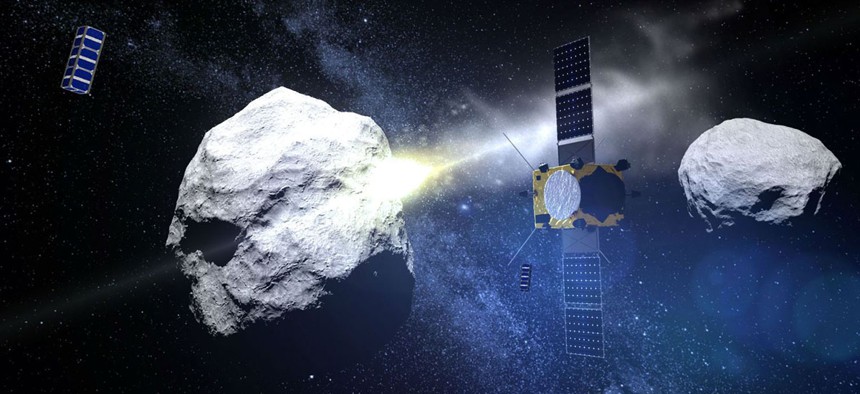
ESA/ScienceOffice.org
NASA and ESA are Teaming Up to Prevent Armageddon
This will be the first real asteroid deflection test.
The American and European space agencies are teaming up to save the world, and they’re doing it all without cheesy Aerosmith songs (video) or bad Ben Affleck haircuts .
Back in 2012, NASA and the European Space Agency (ESA) announced that they were joining forces to study potentially hazardous near-Earth asteroids, and how best to deflect them. The project, called Asteroid Impact & Deflection Assessment (AIDA), kicked into high gear earlier this year, when ESA revealed the unlucky test subject: 65803 Didymos, a binary asteroid system in which a small asteroid orbits a larger one.
The mission requires two spacecrafts—one from ESA, and one from NASA, and both with endearingly appropriate names. First, ESA’s Asteroid Impact Mission (AIM) will launch in 2020 and head to Didymos to study the orbit and physical composition of both it and its smaller partner, colloquially known as “Didymoon.” While AIM examines the asteroids, NASA’s Double Asteroid Redirection Test (DART) will launch in 2022.
Once it reaches the system, DART will Kamikaze itself into Didymoon.
AIM will monitor DART’s impact and send the data back to Earth using a long-range laser communication link. Didymoon is only 160 meters in diameter (525 feet), so it’s not a large asteroid by any means—certainly not as large as the one from Armagaddeon , which required Bruce Willis fly a nuclear bomb into it. But the two space probes should still provide some invaluable information. NASA and ESA hope to learn how the impact affects Didymoon’s orbit, and, ultimately, how much force would be needed to steer an asteroid headed for Earth off its course.
“To protect Earth from potentially hazardous impacts, we need to understand asteroids much better,” said Patrick Michel, head of the AIM team, at the European Planetary Science Congress on Sept. 30. “AIDA will be the first mission to study an asteroid binary system, as well as the first to test whether we can deflect an asteroid through an impact with a spacecraft.”
Slamming a spacecraft (or, yes, even a bomb) into an asteroid is only one of several proposed ideas about how best to avoid the apocalypse. Other ideas include gravity “tractors,” ion thruster beams, and, best of all, giant magnets .
We trust NASA and ESA know what they’re doing. It’s not like humanity’s survival depends on it.







